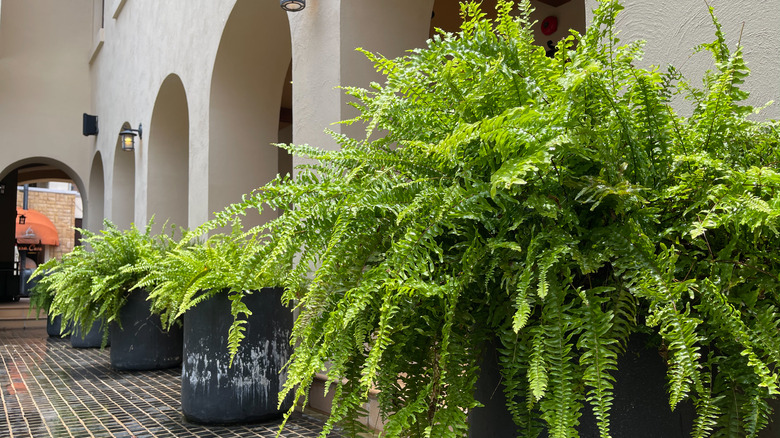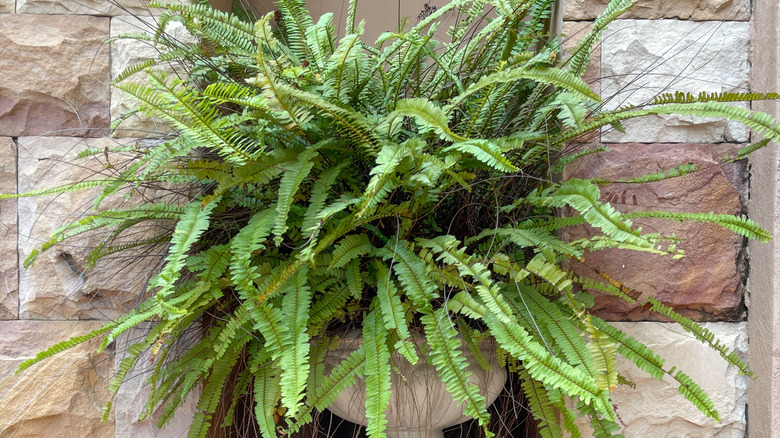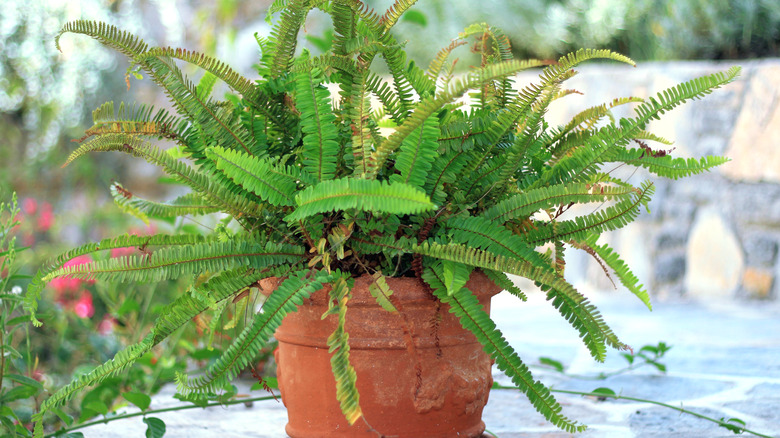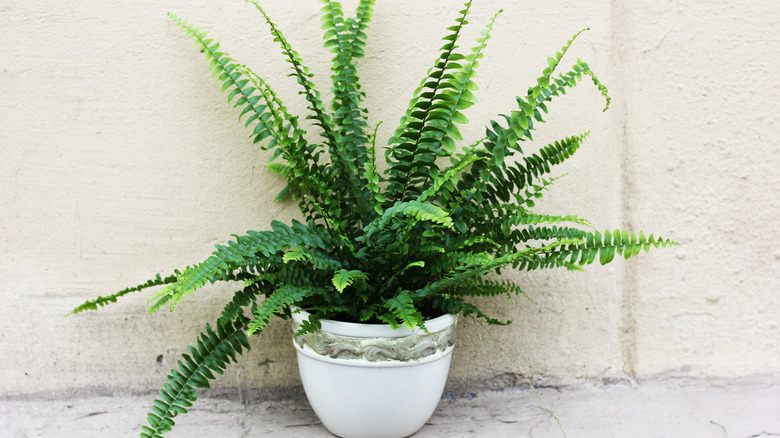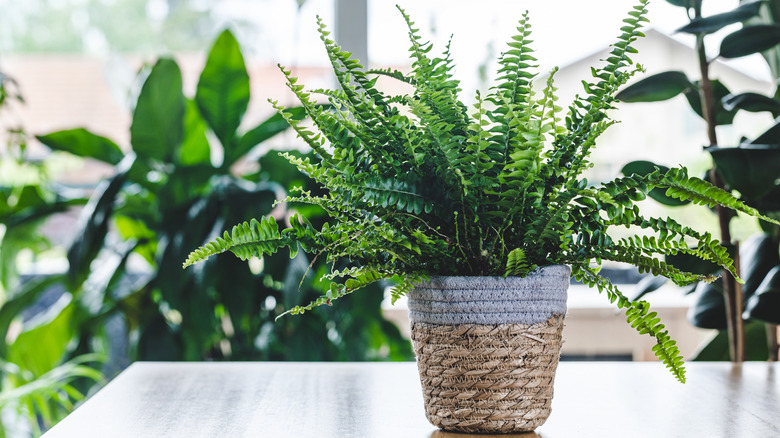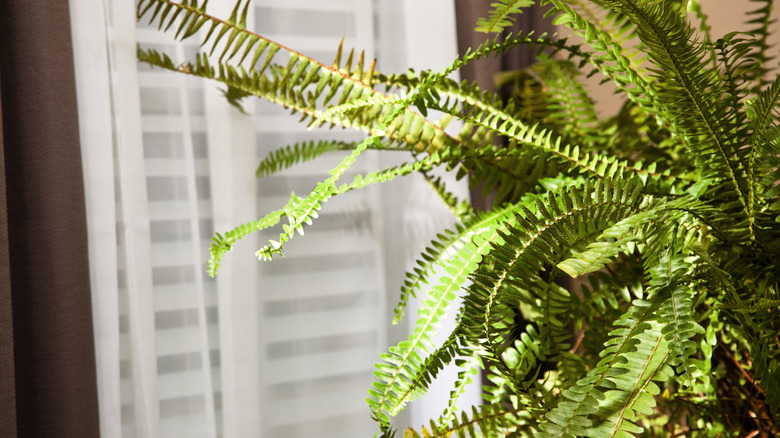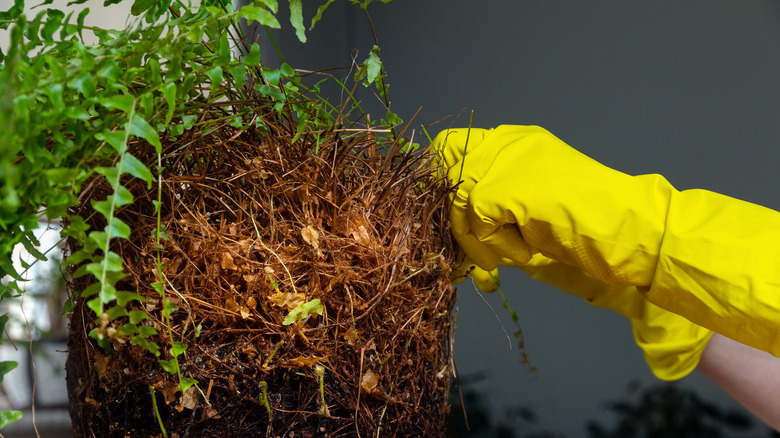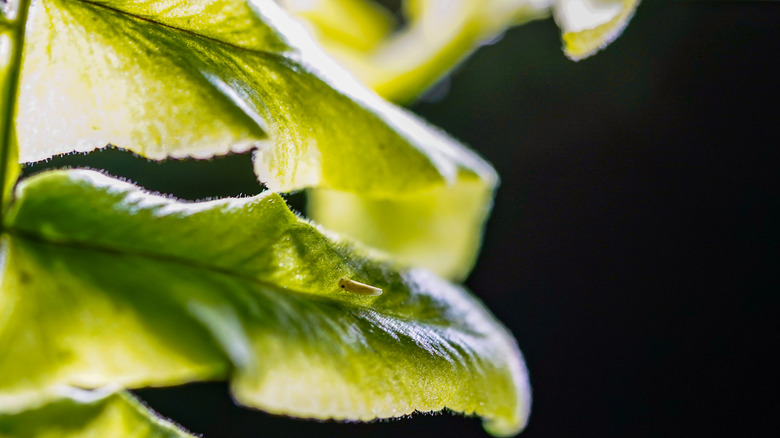How To Grow And Take Care Of A Kimberley Queen Fern
The Kimberley Queen fern, also known as the sword fern, or by its botanical name Nephrolepis obliterata, is a species of perennial fern that is indigenous to Australia. The name comes from the region of Australia, called Kimberley, where it was discovered. Its other nickname, the sword fern, comes from the appearance of the plant. While most ferns grow in similar structures, this one has distinctly narrower, sword-shaped leaves, which can grow up to 3 feet tall and 4 feet wide.
Similar to most other ferns, Kimberley Queen ferns can be grown indoors or out, as long as they are given proper care so that their needs are met. A bonus of the Kimberley Queen fern is that it is completely non-toxic to humans, cats, dogs, and horses, per The Organic Goat Lady. Keep reading if you would like to learn how to care for this great plant.
How to use a Kimberley Queen fern in garden
Gardeners throughout the world like to hang ferns outdoors during the warm months, as the plants love the seasonal humidity. Most people don't know about the plant's potential for garden longevity, however. That being said, Kimberley Queen ferns can only be grown outdoors year-round in USDA hardiness zones 9-11. Places like Texas, Southern California, Florida, and other consistently warm climates are best suited for long-term outdoor care. For those in colder climates, consider potting your sword fern and bringing it indoors once temperatures begin to drop.
Kimberley Queen ferns are also rabbit, pest, and deer-resistant, making them great for garden borders, or to protect other flowers that wildlife may be interested in. While many people prefer to hang ferns from baskets to fully see the effect of their large fronts, planting them in containers or directly in the ground can yield a similarly impressive visual effect.
If you want to design your backyard or garden around a Kimberley queen fern, you can use begonias, caladiums, and New Guinea impatiens for companion plants. If you choose to grow begonias, these blooms will contrast against the fern's heavy foliage with a bright pop of color. Caladiums also bear big, dramatic leaves that will complement Kimberley Queen ferns. Lastly, the New Guinea variety of impatiens hails from the same region of the world, making them a natural garden pairing.
How to grow a Kimberley Queen fern
Growing a new Kimberley Queen fern is quite an interesting task, and far different from run-of-the-mill stem cutting or propagation by root division. While you can obviously purchase a new plant, you can also grow these ferns from spores. Instead of growing seeds like other plants, ferns grow spores on their leaves that can be collected and germinated.
To do this, look for a frond covered in spores, which will look like little brown polka dots. Then, gather a paper bag and a plant stake. Wrap the paper bag around the spore-bearing frond, and use the stake to support it in place. Remove the bag after ten days or so. The inside will be covered in the spores, which will manifest as brown dust.
In a seed starter or germination tray filled with sphagnum moss and potting soil, shake out the spores and cover with the lid. After a little while, the fronds will start to grow, at which point you can set the lid slightly ajar for air circulation, removing the lid completely after a week. When the plants have grown to a decent size, repot them in their own pot, and care for them as usual.
How to care for a Kimberley Queen fern
Most ferns, the Kimberley Queen fern included, have similar care and maintenance needs to best mimic their natural environment. Ferns are known to grow in shadier spots, though they prefer bright but indirect light. The Kimberley Queen firm can also tolerate full sun, but be aware that it will need to be watered more frequently, or else the fronds may turn brown. Water your Kimberley Queen fern when the top quarter of the soil is dry.
Something all ferns need is high humidity. The challenge of ferns, then, is that moisture can attract pests. To keep this from happening, either place the fern in an already humid room, like a bathroom or kitchen, or use tools that will let the plant regulate its own humidity, like a pebble tray or plant humidifier with a moisture meter. You can also choose to manually mist your fern regularly.
Kimberley Queen ferns don't like to be any colder than 65 degrees Fahrenheit. If you wish, you can move your plant outdoors during consistently warm weather. Kimberley Queen ferns prefer to be fed every three months or so with a liquid houseplant fertilizer, diluted to half-strength. Be careful never to feed a dry fern, as the leaves may burn and die.
Kimberley Queen fern varieties
The Kimberley Queen fern, though very unique and visually appealing, is far from the only viable fern variety. Ferns have a long, long history – PlantSnap explains that ferns are over 70 million years old, with over 10,000 species. If you want to add some more prehistoric-inspired greenery to your home, there are a variety of species you can try. One is the kangaroo paw fern (Microsorium diversifolium), which also hails from Australia and has dark green leaves that grow in the same shape as typical ferns, but with one long stem instead of fluffy fronds. You can also opt for the lady fern, also known as Athyrium filix-femina, which has a lighter-green shade with lacy, fluffier leaves.
The asparagus fern (Asparagus aethiopicus) is another great option; identifiable by its soft, fuzzy, fine leaves that produce small red berries. Maidenhair Fern (Adiantum spp.) is a genus of fern that contains a few different species with different growing habits, but similarly delicate appearances, with smaller, lighter green, circular-shaped leaves. Finally, the widely-known Boston fern (Nephrolepis exaltata) belongs to the same genus as the Kimberley Queen fern and is also very similar in appearance, except that its leaves are a little more uniform and needle-like.
Differences between the Kimberley Queen and Boston ferns
At first glance, it can be difficult to tell the difference between Kimberley Queen and Boston ferns, but there are some subtleties that make them more suitable for different types of displays. Although Kimberley Queens can be grown in hanging baskets, Boston ferns are more often used in this type of planter because their fronds are more supple, giving them the nice flowing shape that works so well in those arrangements. Kimberley Queen fern fronds are stiffer with a more upright growth habit, making them ideal for urns, window planters, and other ground-level displays. If you look closely, Kimberley Queen leaves are also more narrow.
Another big difference between these two beautiful ferns is their availability. Since Boston ferns are so commonly grown as an outdoor hanging annual, they pop up everywhere in the spring. You'll find this species in nearly every garden center, big box store, and grocery store, but you may have to search a little harder to find a Kimberley Queen fern.
How to repot a Kimberley Queen fern
Kimberley Queen ferns prefer to be a little root-bound, but that doesn't mean they don't need the occasional repotting. You should repot the fern once you notice that roots have begun to grow through the top of the soil. If you suspect it's time to repot your fern, stop fertilizing for at least a month beforehand, in order to prevent potentially burning the leaves.
Prepare a new planter that is 1 or 2 inches larger than the last, making sure that it has plenty of drainage holes. Kimberley Queen ferns prefer rich, well-draining soil, leaning more acidic or neutral as opposed to alkaline. Consider incorporating soil amendments like peat moss and/or perlite for increased water drainage.
Begin by removing the fern from its current pot, and use your hands to gently but firmly untangle the roots and shake loose as much old dirt as possible. Add enough soil to the new pot so that the fern will sit just a couple of inches below the rim. Then, fill in any remaining space with soil, ensuring that all of the roots are covered, but that the crown of the plant isn't buried. Water thoroughly until you see liquid run out of the drainage holes, and let drain completely.
Pests and disease issues
Ferns are generally resistant to pests and disease issues, but they can still be affected by the most common problems. Spider mites and aphids will take over almost any kind of outdoor plant as a source of food, and ferns are no exception. An organic solution to these tiny, yet prolific, problems is a neem oil spray. Be careful using this if your fern is in full sun because the oil can cause the leaves to burn. If you are facing an infestation, place your Kimberley Queen fern in the shade, and treat it until you no longer see the pests. Rinse the leaves with fresh water before putting your plant back in place. Spraying regularly with soapy water can help deal with small numbers of pests and prevent them from returning.
Although they are not exactly considered pests, birds can cause damage to ferns because they are such an appealing place to make a nest. Frequent movement around your planter and the removal of nesting materials from your Kimberley Queen fern will send birds elsewhere to make their nest.
